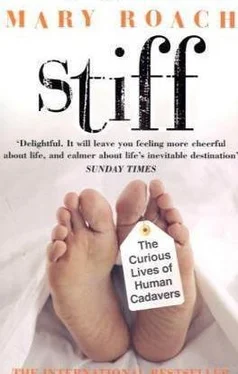Mary Roach - Stiff
Здесь есть возможность читать онлайн «Mary Roach - Stiff» весь текст электронной книги совершенно бесплатно (целиком полную версию без сокращений). В некоторых случаях можно слушать аудио, скачать через торрент в формате fb2 и присутствует краткое содержание. Город: New York, Год выпуска: 2003, ISBN: 2003, Издательство: Viking, Жанр: sci_popular, История, на английском языке. Описание произведения, (предисловие) а так же отзывы посетителей доступны на портале библиотеки ЛибКат.
- Название:Stiff
- Автор:
- Издательство:Viking
- Жанр:
- Год:2003
- Город:New York
- ISBN:0-670-91217-4
- Рейтинг книги:4 / 5. Голосов: 2
-
Избранное:Добавить в избранное
- Отзывы:
-
Ваша оценка:
- 80
- 1
- 2
- 3
- 4
- 5
Stiff: краткое содержание, описание и аннотация
Предлагаем к чтению аннотацию, описание, краткое содержание или предисловие (зависит от того, что написал сам автор книги «Stiff»). Если вы не нашли необходимую информацию о книге — напишите в комментариях, мы постараемся отыскать её.
—
Stiff In this fascinating, ennobling account, Mary Roach visits the good deeds of cadavers over the centuries—from the anatomy labs and human-sourced pharmacies of medieval and nineteenth-century Europe to a human decay research facility in Tennessee, to a plastic surgery practice lab, to a Scandinavian funeral directors’ conference on human composting. In her droll, inimitable voice, Roach tells the engrossing story of our bodies when we are no longer with them.
Stiff — читать онлайн бесплатно полную книгу (весь текст) целиком
Ниже представлен текст книги, разбитый по страницам. Система сохранения места последней прочитанной страницы, позволяет с удобством читать онлайн бесплатно книгу «Stiff», без необходимости каждый раз заново искать на чём Вы остановились. Поставьте закладку, и сможете в любой момент перейти на страницу, на которой закончили чтение.
Интервал:
Закладка:
In cases where the heartbeat and pulse are especially faint—drownings, stroke, certain types of narcotic poisoning—even the most scrupulous physician had difficulty telling, and patients ran the risk of being dispatched to the undertaker before they’d actually expired.
To allay patients’ considerable fears of live burial, as well as their own insecurities, eighteenth- and nineteenth-century physicians devised a diverting roster of methods for verifying death. Welsh physician and medical historian Jan Bondeson collected dozens of them for his witty and admirably researched book Buried Alive . The techniques seemed to fall into two categories: those that purported to rouse the unconscious patient with unspeakable pain, and those that threw in a measure of humiliation. The soles of the feet were sliced with razors, and needles jammed beneath toenails. Ears were assaulted with bugle fanfares and “hideous Shrieks and excessive Noises.” One French clergyman recommended thrusting a red-hot poker up what Bondeson genteelly refers to as “the rear passage.” A French physician invented a set of nipple pincers specifically for the purpose of reanimation. Another invented a bagpipelike contraption for administering tobacco enemas, which he demonstrated enthusiastically on cadavers in the morgues of Paris. The seventeenth-century anatomist Jacob Winslow entreated his colleagues to pour boiling Spanish wax on patients’ foreheads and warm urine into their mouths. One Swedish tract on the matter suggested that a crawling insect be put into the corpse’s ear. For simplicity and originality, though, nothing quite matches the thrusting of “a sharp pencil” up the presumed cadaver’s nose.
In some cases, it is unclear who was the more humiliated, patient or doctor. French physician Jean Baptiste Vincent Laborde wrote at great length of his technique of rhythmic tongue-pulling, which was to be carried out for no less than three hours following the suspected death. (He later invented a hand-cranked tongue-pulling machine, which made the task less unpleasant though only marginally less tedious.) Another French physician instructed doctors to stick one of the patient’s fingers in their ear, to listen for the buzzing sound produced by involuntary muscle movement.
Not all that surprisingly, none of these techniques gained wide acceptance, and most doctors felt that putrefaction was the only reliable way to verify that someone was dead. This meant that corpses had to sit around the house or the doctor’s office for two or three days until the telltale signs and smells could be detected, a prospect perhaps even less appealing than giving them enemas. And so it was that special buildings, called waiting mortuaries, were built for the purpose of warehousing the moldering dead. These were huge, ornate halls, common in Germany in the 1800s. Some had separate halls for male and female cadavers, as though, even in death, men couldn’t be trusted to comport themselves respectably in the presence of a lady. Others were segregated by class, with the well-to-do deceased paying extra to rot in luxury surroundings.
Attendants were employed to keep watch for signs of life, which they did via a system of strings linking the fingers of corpses to a bell [26] I read on a Web site somewhere that this was the origin of the saying “Saved by the bell.” In fact, by one reckoning, not a single corpse of the million-plus sent to waiting mortuaries over a twenty-year period awakened. If the bell alerted the attendant, which it often did, it was due to the corpse’s shifting and collapsing as it decomposed. This was the origin of the saying “Driven to seek new employment by the bell,” which you don’t hear much anymore and probably never did, because I made it up.
or, in one case, the bellows of a large organ, so that any motion on the part of the deceased would alert the attendant, who was posted, owing to the considerable stench, in a separate room. As years passed and not a single resident was saved, the establishments began to close, and by 1940, the waiting mortuary had gone the way of the nipple pincer and the tongue puller.
If only the soul could be seen as it left the body, or somehow measured.
That way, determining when death had occurred would be a simple matter of scientific observation. This almost became a reality, at the hands of a Dr. Duncan Macdougall, of Haverhill, Massachusetts. In 1907, Macdougall began a series of experiments seeking to determine whether the soul could be weighed. Six dying patients, one after another, were installed on a special bed in Macdougall’s office that sat upon a platform beam scale sensitive to two-tenths of an ounce. By watching for changes in the weight of a human being before, and in the act of, dying, he sought to prove that the soul had substance. Macdougall’s report of the experiment was published in the April 1907 issue of American Medicine , considerably livening up the usual assortment of angina and urethritis papers. Below is Macdougall describing the first subject’s death. He was nothing if not thorough.
At the end of three hours and forty minutes he expired and suddenly coincident with death the beam end dropped with an audible stroke hitting against the lower limiting bar and remaining there with no rebound. The loss was ascertained to be three-fourths of an ounce.
This loss of weight could not be due to evaporation of respiratory moisture and sweat, because that had already been determined to go on, in his case, at the rate of one-sixtieth of an ounce per minute, whereas this loss was sudden and large….
The bowels did not move; and if they had moved the weight would still have remained upon the bed except for a slow loss by the evaporation of moisture, depending, of course, upon the fluidity of the feces. The bladder evacuated one or two drams of urine. This remained upon the bed and could only have influenced the weight by slow gradual evaporation and therefore in no way could account for the sudden loss.
There remained but one more channel of loss to explore, the expiration of all but the residual air in the lungs. Getting upon the bed myself, my colleague put the beam at actual balance. Inspiration and expiration of air as forcibly as possible by me had no effect upon the beams….
After watching another five patients shed similar weight as they died, Macdougall moved on to dogs. Fifteen dogs breathed their last without registering a significant drop in weight, which Macdougall took as corroborating evidence, for he assumed, in keeping with his religious doctrine, that animals have no souls. While Macdougall’s human subjects were patients of his, there is no explanation of how he came to be in the possession of fifteen dying dogs in so short a span of time. Barring a local outbreak of distemper, one is forced to conjecture that the good doctor calmly poisoned fifteen healthy canines for his little exercise in biological theology.
Macdougall’s paper sparked an acrid debate in the American Medicine letters column. Fellow Massachusetts doctor Augustus P. Clarke took Macdougall to task for having failed to take into account the sudden rise in body temperature at death when the blood stops being air-cooled via its circulation through the lungs. Clarke posited that the sweating and moisture evaporation caused by this rise in body temperature would account both for the drop in the men’s weight and the dogs’ failure to register one. (Dogs cool themselves by panting, not sweating.) Macdougall rebutted that without circulation, no blood can be brought to the surface of the skin and thus no surface cooling occurs. The debate went on from the May issue all the way through December, whereupon I lost the thread, my eye having strayed across the page to “A Few Points in the Ancient History of Medicine and Surgery,” by Harry H. Grigg, M.D. It is with thanks to Harry H. Grigg that I can now hold forth at cocktail parties on the history of hemorrhoids, gonorrhea, circumcision, and the speculum. [27] Since the odds of our meeting at a cocktail party are slim and the odds of my managing to swing the conversation around to speculums slimmer still, let me take this opportunity to share: The earliest speculum dates from Hippocrates’ day and was a rectal model. It was to be another five hundred years before the vaginal speculum made its debut. Dr. Grigg theorizes that this was because, in the Arabian model of medicine followed at the time, women could be examined only by women, and there were very few women doctors to do the examining. This implies that most women in Hippocrates’ day never went to the gyno. Given that the Hippocratic gynecological cabinet included cow-dung pessaries and fumigation materials “of heavy and foul smell”—not to mention rectal speculums—they were probably better off.
Интервал:
Закладка:
Похожие книги на «Stiff»
Представляем Вашему вниманию похожие книги на «Stiff» списком для выбора. Мы отобрали схожую по названию и смыслу литературу в надежде предоставить читателям больше вариантов отыскать новые, интересные, ещё непрочитанные произведения.
Обсуждение, отзывы о книге «Stiff» и просто собственные мнения читателей. Оставьте ваши комментарии, напишите, что Вы думаете о произведении, его смысле или главных героях. Укажите что конкретно понравилось, а что нет, и почему Вы так считаете.












